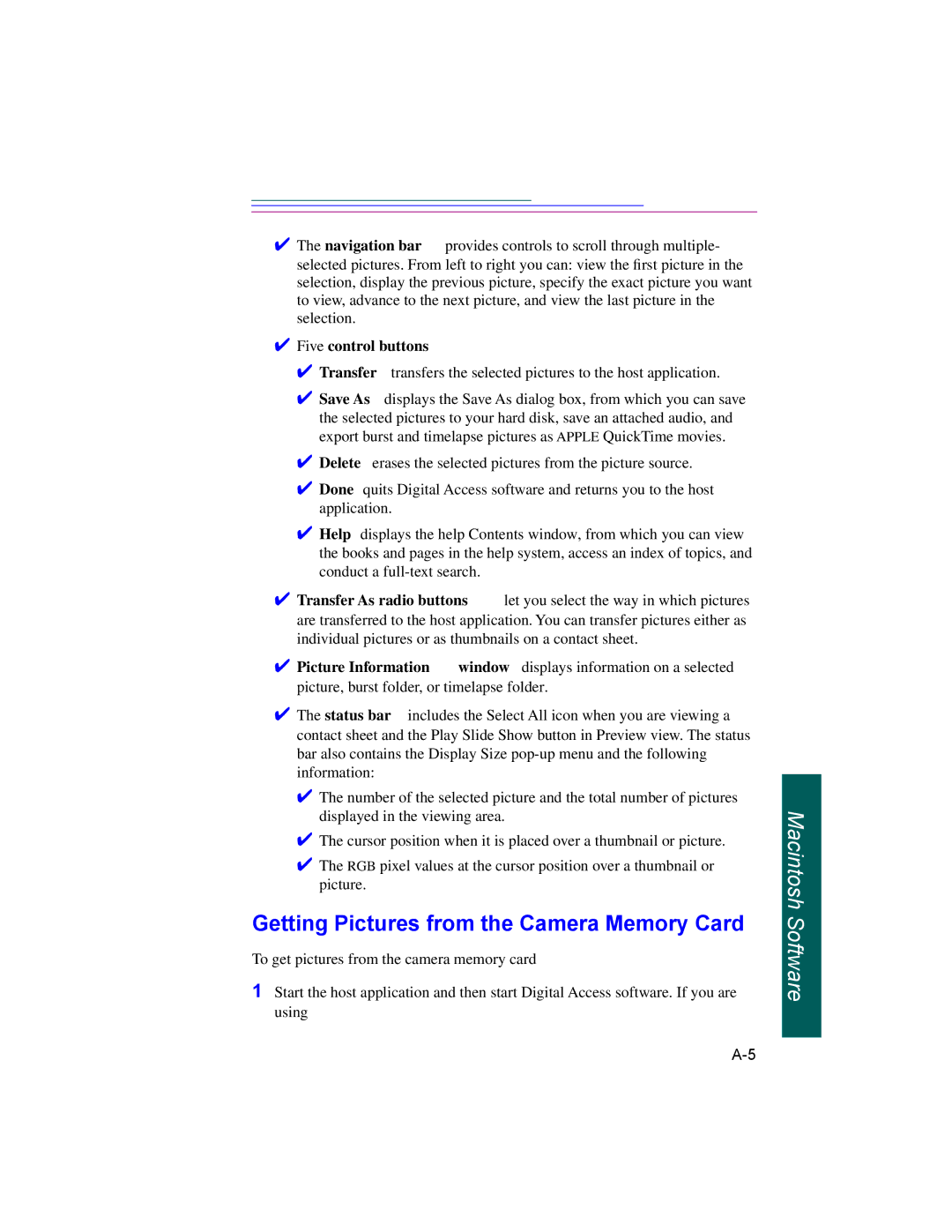UserÕs Guide
Page
Contents
Reviewing your pictures
Accessing your pictures via computer
Tips and troubleshooting
Vii
So where is the Þlm?
Camera features
Getting started
Typical uses for your camera
Add sound to your picture
DC220 and DC260 software
System Requirements
Camera Accessories Item Number
Number
Not all accessories are available in all countries
Meet your camera
Your Digital Camera
Softkeys
Mode dial
Softkeys
Four-way controller
Your camera display
Flash
Exposure Compensation
Picture Type
Brief detour to discuss quality and resolution
Quality
Self-Timer
Close Up DC220 only
Batteries
Pictures Remaining
Manual Mode
Infrared Communication
Initiating communication
Searching for communication partner
Removable memory card
Reformatting the memory card
My Computer window appears
Power management
Removing the memory card
Installing batteries
Always follow your battery manufacturers directions fully
Using the AC adapter
Taking pictures
Entering the Capture mode
Turning the camera on
Camera moves the lens to a point away from the camera
DeÞning settings
DeÞning settings via the Capture mode menus
Picture Type settings
Settings for the selected picture type appear
Album settings DC260 only
Script setting
White Balance settings
Watermark settings
Advanced Exposure Modes settings
Advanced Focus Mode settings DC260 only
Preferences settings
Capture
Date and Time
Date and Time screen appears again
Camera Name
DeÞning settings via the Scroll and Select buttons
Setting Flash, Exposure, Picture Type, and Quality
Setting the Self-Timer and Close-up settings DC220 only
Taking pictures
Viewing the memory gauge
Adding sound to a picture
When you are done recording, release the Record button
Zooming
Digital zooming
Digital zoom is disabled when you turn the LCD off
Entering the Review mode
Reviewing your pictures
Setting Review mode preferences
Review Mode Settings screen appears
LCD returns to the thumbnail or full screen
Overlay preferences
Slideshow preferences
Video preferences
Playback preferences
Viewing pictures
filmstrip scrolls until you release the arrow button
Scroll to find the picture you want to select
Placing marked pictures in an album DC260 only
Marked pictures are moved to the selected album
Creating a new album
New Album Name screen appears
Copying marked pictures from camera to camera
Marked pictures are copied from one camera to the other
Opening albums
Expanding and collapsing pictures
Press the Expand softkey
Adding sound to pictures
Now has attached sound. If a picture has
Attached sound, pressing the Delete
Or both the picture and sound
Delete, Sound Only, and Cancel softkeys appear
Deleting one picture
Deleting multiple or all pictures
Playing sound, bursts, and timelapse sequences
Magnifying pictures
Screen displays a magnified view of the selected picture
Viewing pictures on your TV
Setting camera properties
YouÕve got to connect Þrst
Finding the Properties software
Specifying General settings
Additional settings appear
YourCamera cameraproperties
Specifying Camera settings
Specifying Picture Type settings
High
Mode settings on the camera
Resolution , Interval , and Number of Pictures, the number
Specifying Albums settings DC260 only
Connecting your camera to your computer
Entering the Connect mode
Which connection?
RS-232 Serial
Connecting via a serial cable
This connector is normally on the back of the computer
On your desktop, click Start Settings Control Panel
Connecting via a USB cable
Infrared transceiver
On your computer, click Start Settings Control Panel
Connecting via an infrared transceiver
Potential connection problems
Accessing your pictures via computer
Using the Mounter software
Installing Mounter software
Mounter software overview
YouÕve got to connect Þrst
Viewing your pictures
Transferring pictures to your computer
Transferring pictures and scripts to your camera
Camera Name and System folder icons appear
Window appears listing individual pictures
Creating albums on the camera DC260 only
Opening picture Þles in other software programs
Saving sound
Setting preferences
Placing the memory card in your computer
Exiting Mounter software
Picture Card Adapter
Refer to Removing the memory card on
Picture Card appears as a drive on your computer
Memory Card Reader
Does my computer support a Pcmcia card?
Installing Twain software
Transferring pictures via Twain software
Connecting the camera to your computer
Twain software workßow
Starting the Twain Software
Select appropriate button to
Retrieve pictures from your
Camera or computer
Selecting the cameraÕs contents
Selecting the source of your pictures
Taking a picture
Previewing your pictures
Selecting pictures on your computer
Twain software displays a standard Windows Open window
Play a pictureÕs attached sound
Expanding and collapsing pictures
Opening a picture in full view
Transferring pictures
Displaying picture information
Preferences screen appears
Tips and troubleshooting
General maintenance and safety
Monitor adjustment
Communicating with the computer
Printing
Troubleshooting
Computer Monitor Problem Cause Solution
Memory Card Problem Cause Solution
Camera Problem Cause Solution
Camera Problem Cause Solution
LCD Messages Cause Solution
LCD Messages Problem Cause Solution
Online services
Getting help
Software help
Faxed information
Customer support
Outside the U.S., Canada, and Europe
Fax
10-2
10-3
Kodak Digital Access Software Plug-In Acquire
System and Software Requirements
Installing Digital Access Software
Connecting the Card Reader
Digital Access Application Window
Page
Getting Pictures from the Camera Memory Card
Five control buttons
Open dialog box appears
Select Pictures
Change Thumbnail and Picture Display Size
Single picture
Multiple noncontiguous pictures
Preview View
View a High-resolution Picture
DC260 Camera 100% 50% 25%
View Burst and Timelapse Pictures
Slide Show
Play the Audio Attached to a Picture
Rotate Pictures
Delete Pictures
Getting Pictures from Your Computer
View Picture Information
Transfer Individual Pictures
Transfer Thumbnails on a Contact Sheet
Saving Pictures to Your Computer
Transfer Contact Sheet dialog box appears
Save Individual Pictures
Save the Audio Attached to a Picture
Save As dialog box appears
Export an Apple QuickTime Movie
Click Save
Setting Preferences
Delay at Least x Seconds
Progress indicator appears as the movie is created
QuickTime dialog box appears
Preferences dialog box appears
Page
Warranty and regulatory information
Warranty time period
Warranty repair coverage
Warranty-1
Warranty-2
Limitations
How to obtain service
Warranty-3
Application support
Warranty-4
Regulatory information
FCC compliance and advisory
Canadian DOC statement
Index
Index-1
Select
Index-2
Index-3
Index-4
Index-5
Index-6
Index-7
Index-8
Index-9
Index-10
Index for Appendix a Macintosh Software
Index-11
Index-12
Index-13

